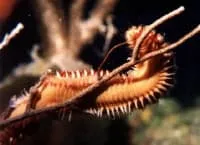Bristleworm Sting Overview
Bristleworms are elongated segmented worms. Each segment contains a pair of bristles. Although bristleworms are not aggressive, they bite when handled, and the bristles can penetrate skin (sting).
Bristleworms are often found under rocks and corals in tropical areas throughout the world - but it's likelier they are in your saltwater aquarium at home. You should use heavy gloves if you need to handle one.
Bristleworm Sting Symptoms
The bristleworm bite or sting may cause the following symptoms:
- Inflammation
- Burning
- Swelling
- Numbness
- Redness
- Pain
Bristleworm Sting Treatment
Treatment for a bristleworm bite or sting includes the following:
- Apply topical acetic acid (vinegar) or isopropyl alcohol.
- Remove bristles with tweezers or adhesive tape.
- If severe inflammation and a continual burning sensation develop, apply hydrocortisone cream 3 times per day.
- If signs of infection are present, such as pus, redness, or heat, apply topical antibiotic ointment and contact your doctor.
- Oral antibiotics are usually recommended if there are signs of infection.
- Pain may be relieved with 1-2 acetaminophen (Tylenol) every 4 hours or 1-2 ibuprofen (Motrin, Advil) every 6-8 hours.
When to Seek Medical Care
Consult a doctor about treatment with available medications if bitten or stung by a bristleworm.
Multimedia
Media file 1: A bristleworm.

Media type: Photo
Media file 2: Another bristleworm. Note obscured view due to camouflaged dorsum.

Media type: Photo
Synonyms and Keywords
fireworm sting, bristleworm, bristle worm
